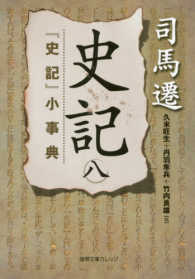- ホーム
- > 洋書
- > 英文書
- > History / World
Full Description
The late 16th century was one of great political and social upheaval, an era in which medieval knights, feudal armies, town levies and hired mercenaries were giving way to modern militaries. Pike and shot had come to dominate the field, and swordplay had become a pastime, as often used to settle affairs of honour as in military matters.
For most students of European Martial Arts, the name Heinrich von Gunterrodt is known as the 16th-century owner of Europe's oldest known fencing text, a c.1300 sword and buckler manuscript (known as Ms. I.33). However, this Saxon nobleman was a swordsman, soldier and fencing historian in his own right. In 1579, he penned a short treatise on the history of fencing, entitled De Veris Principiis Artis Dimicatoriæ (Of the True Principles of the Art of Combat) and dedicated it to Johan Albrecht, Duke of Mecklenburg.
Ostensibly a history, tracing the art of swordsmanship and wrestling from antiquity, the text is also interesting because of the relationships von Gunterrodt draws between fencing and unarmed combat, and his comparisons between what was taught in the fencing schools of his own day with the lessons contained in Ms. I.33. Perhaps of most interest to modern students of swordplay in this period is his scathing critique of the Marxbrüder fencing guild and public fencing contests, or Fechtschulen, which he sees as little more than crudely-skilled, drunken sporting events; a criticism that parallels contemporary writers analysing the fencing guilds and public prize-fights in England and Spain.
This beautiful, full-colour edition presents a full facsimile, transcription and translation of von Gunterrodt's original manuscript, along with complete annotations and comparisons with other Renaissance martial arts texts. A critical analysis of the author's practical fencing advice, by swordplay researcher Robert Rutherfoord (author of The Art and Practice of 16th-Century German Rapier Fencing), is also included. Students of HEMA (Historical European Martial Arts), and those interested more generally in the sweeping changes in the nature and purpose of swordplay, will find this essay a fascinating addition to their libraries.







